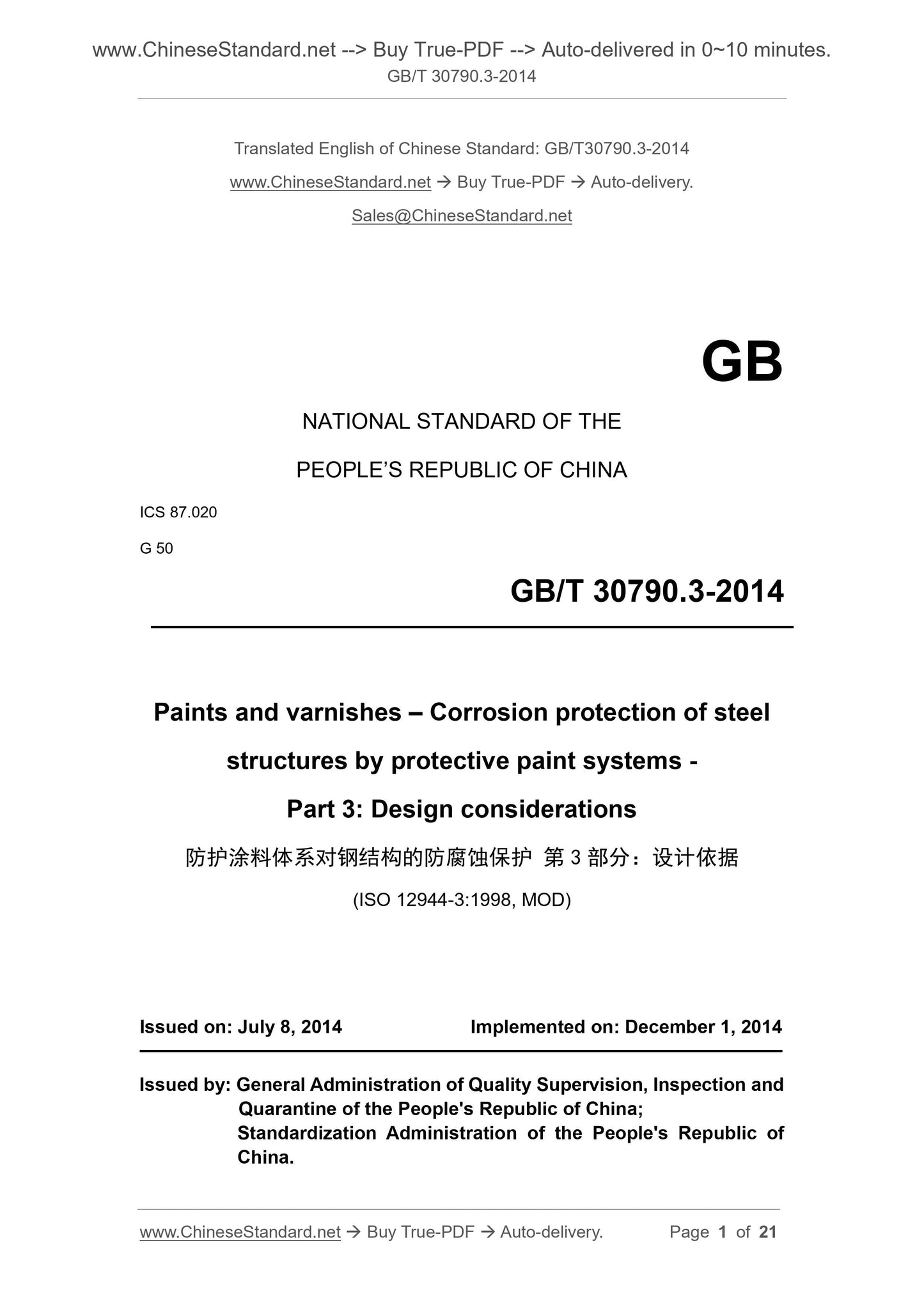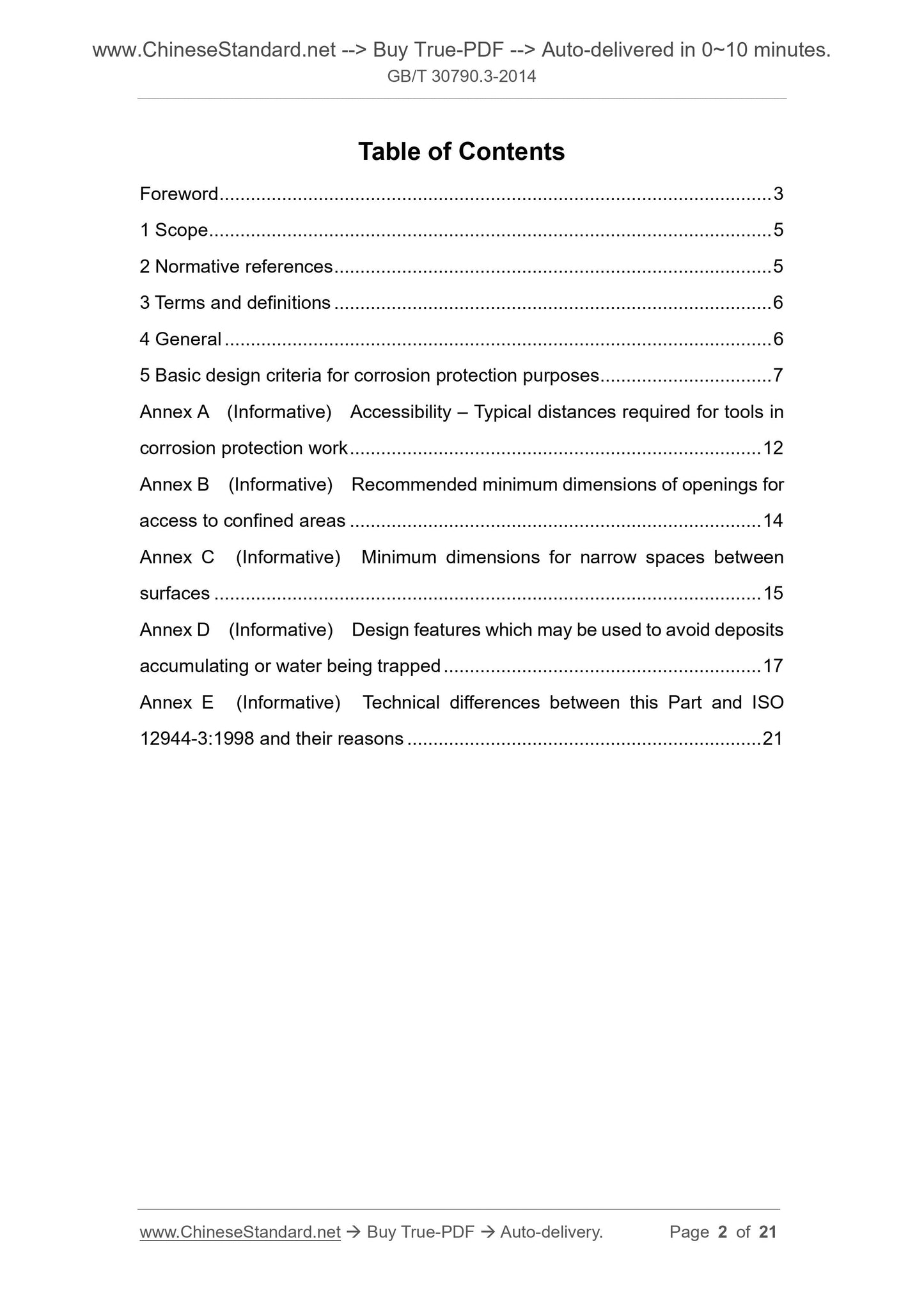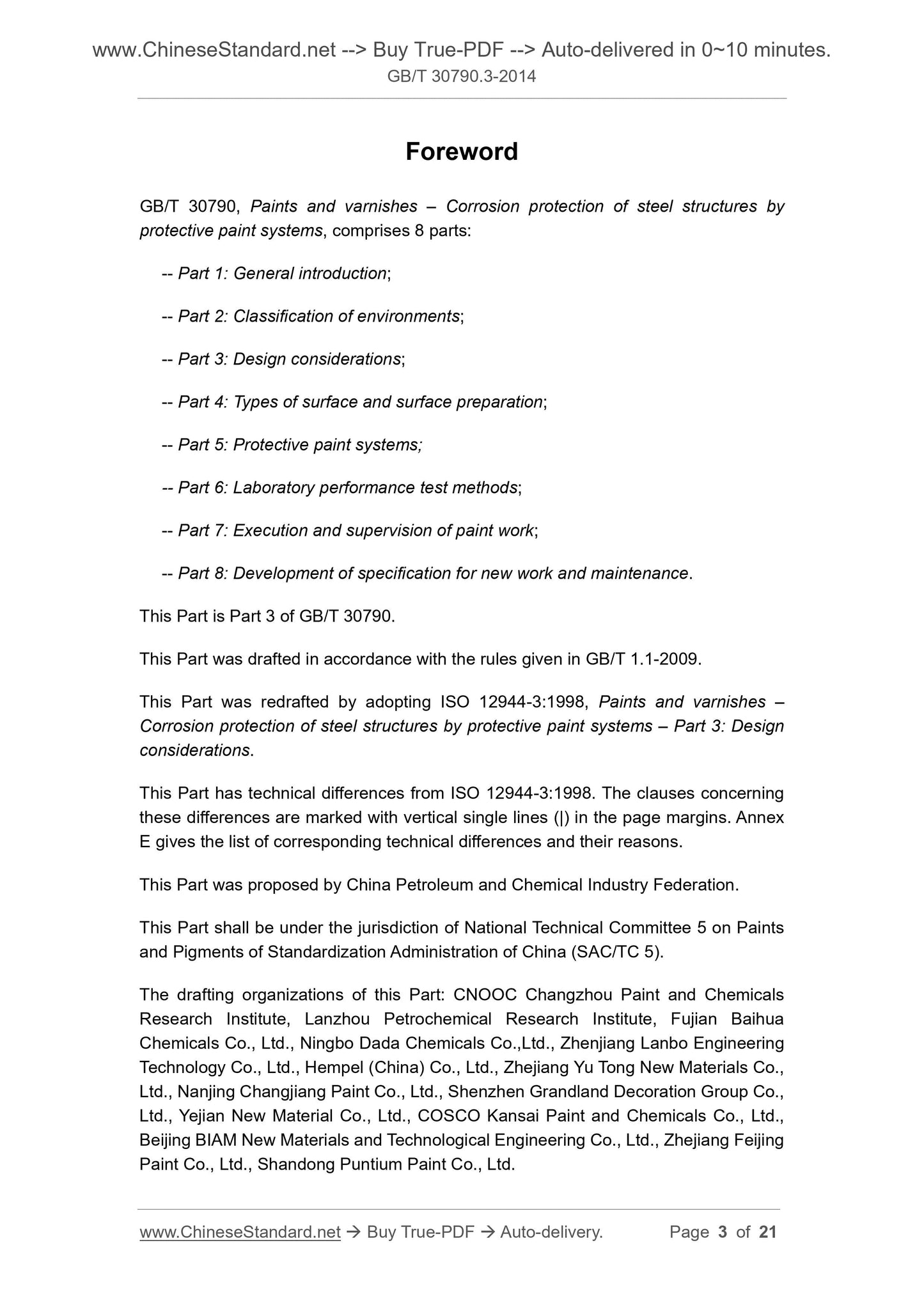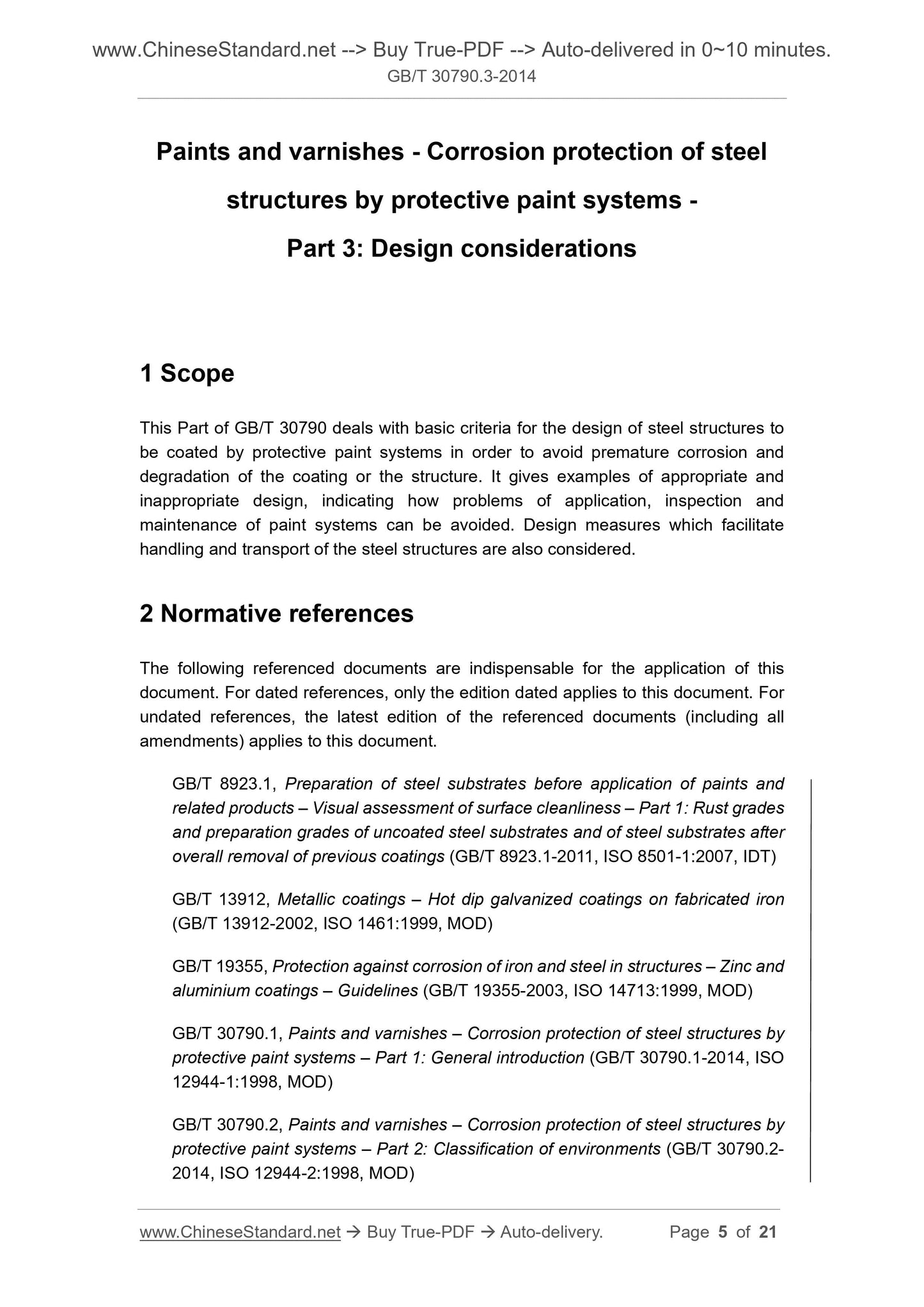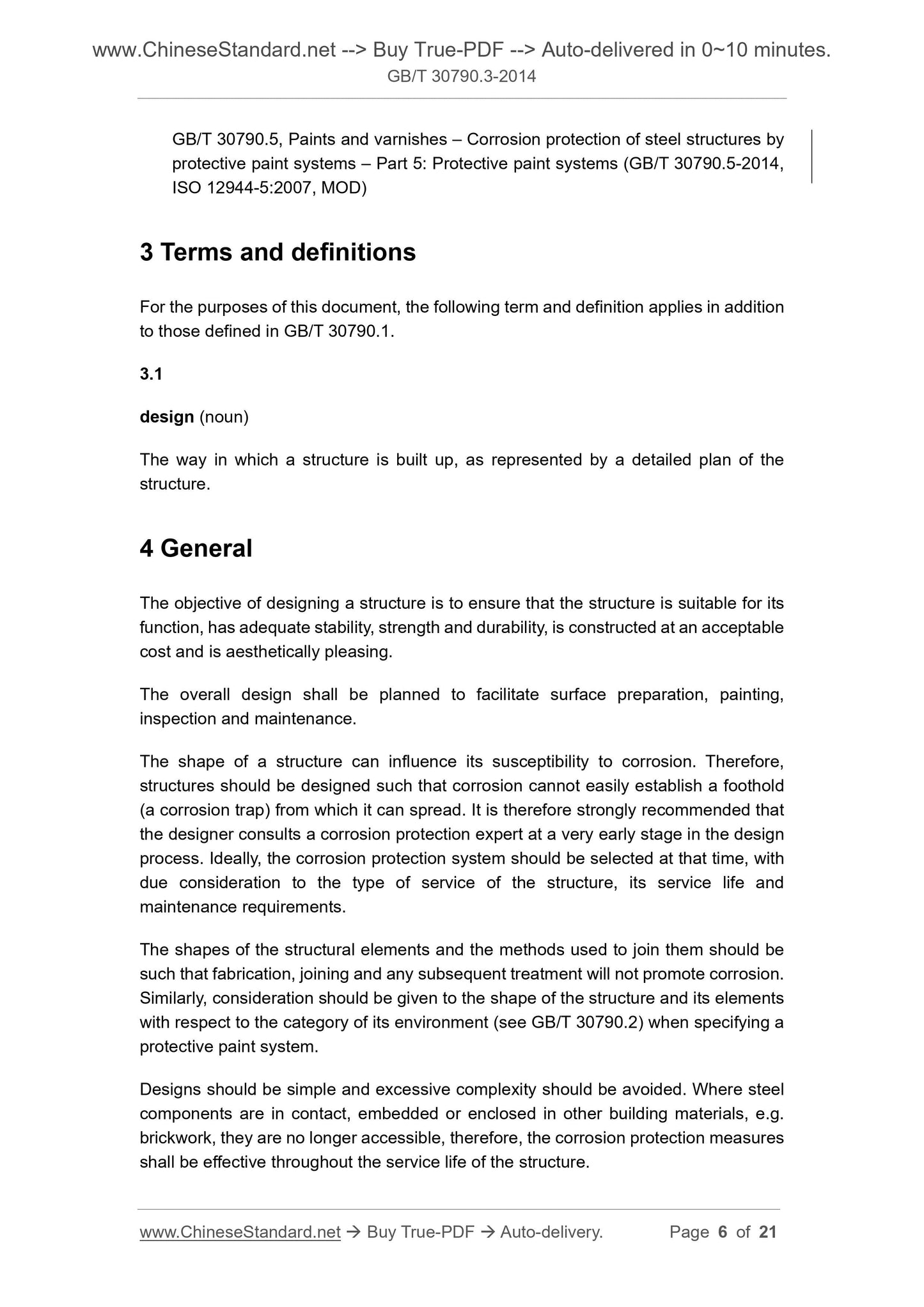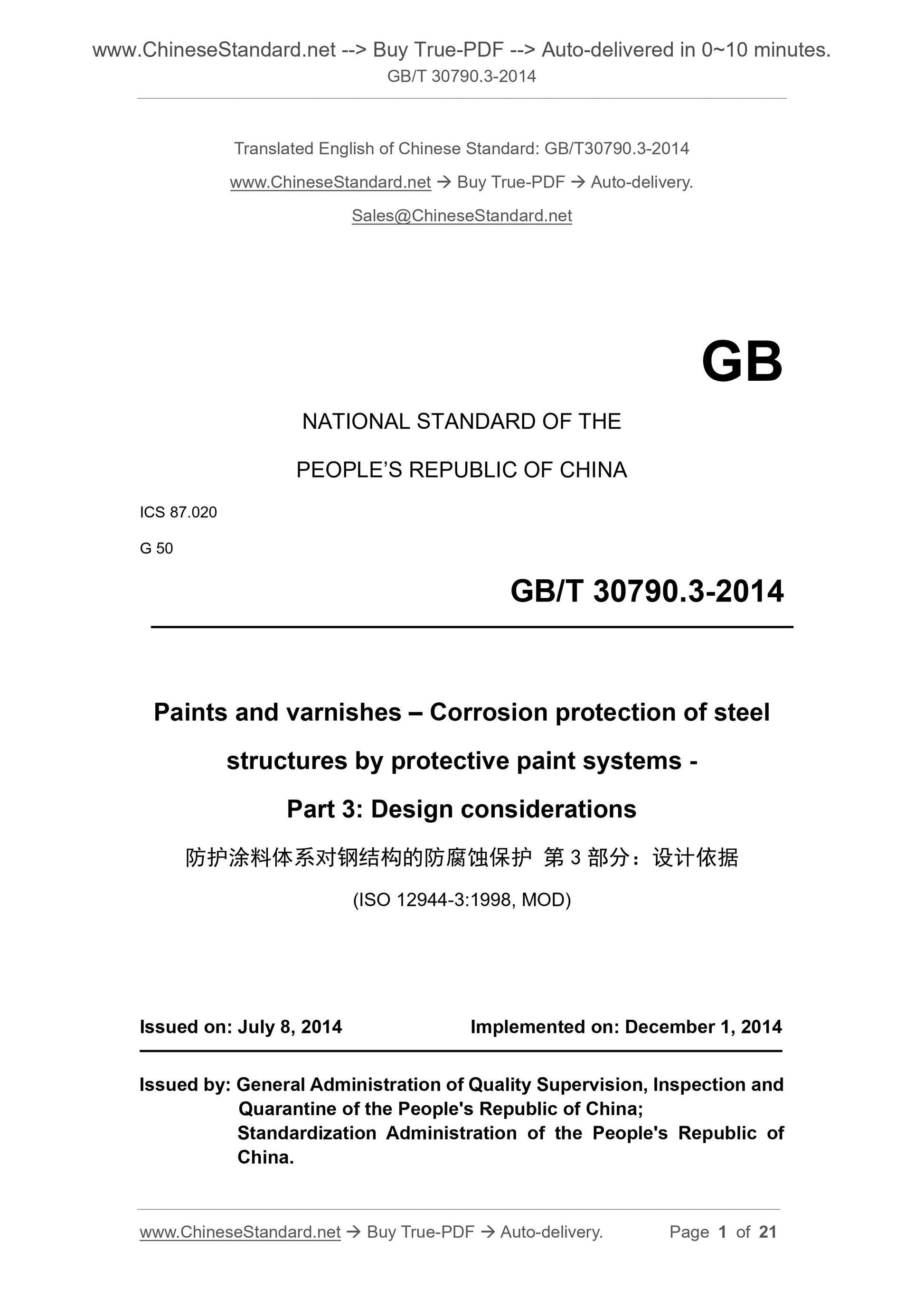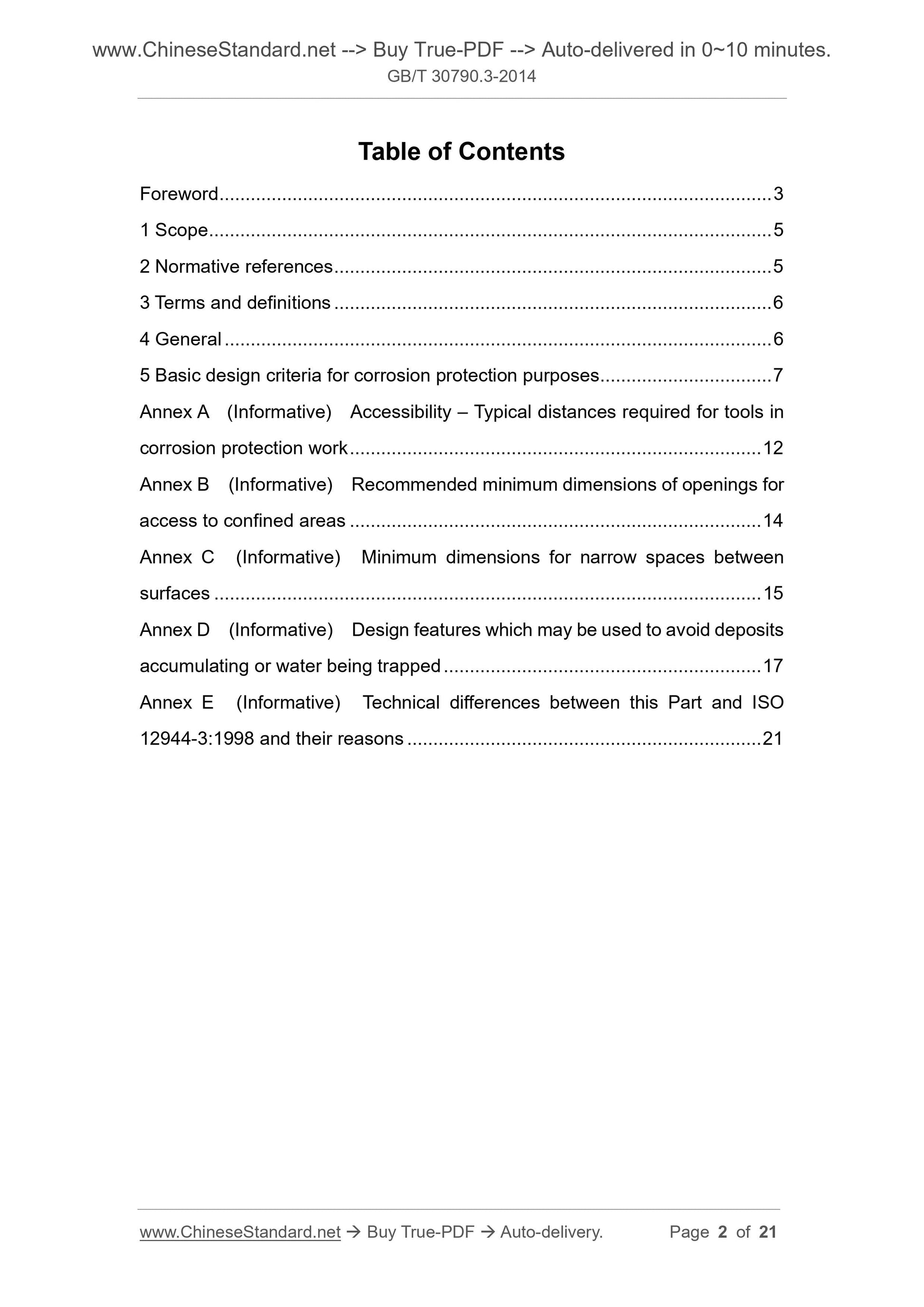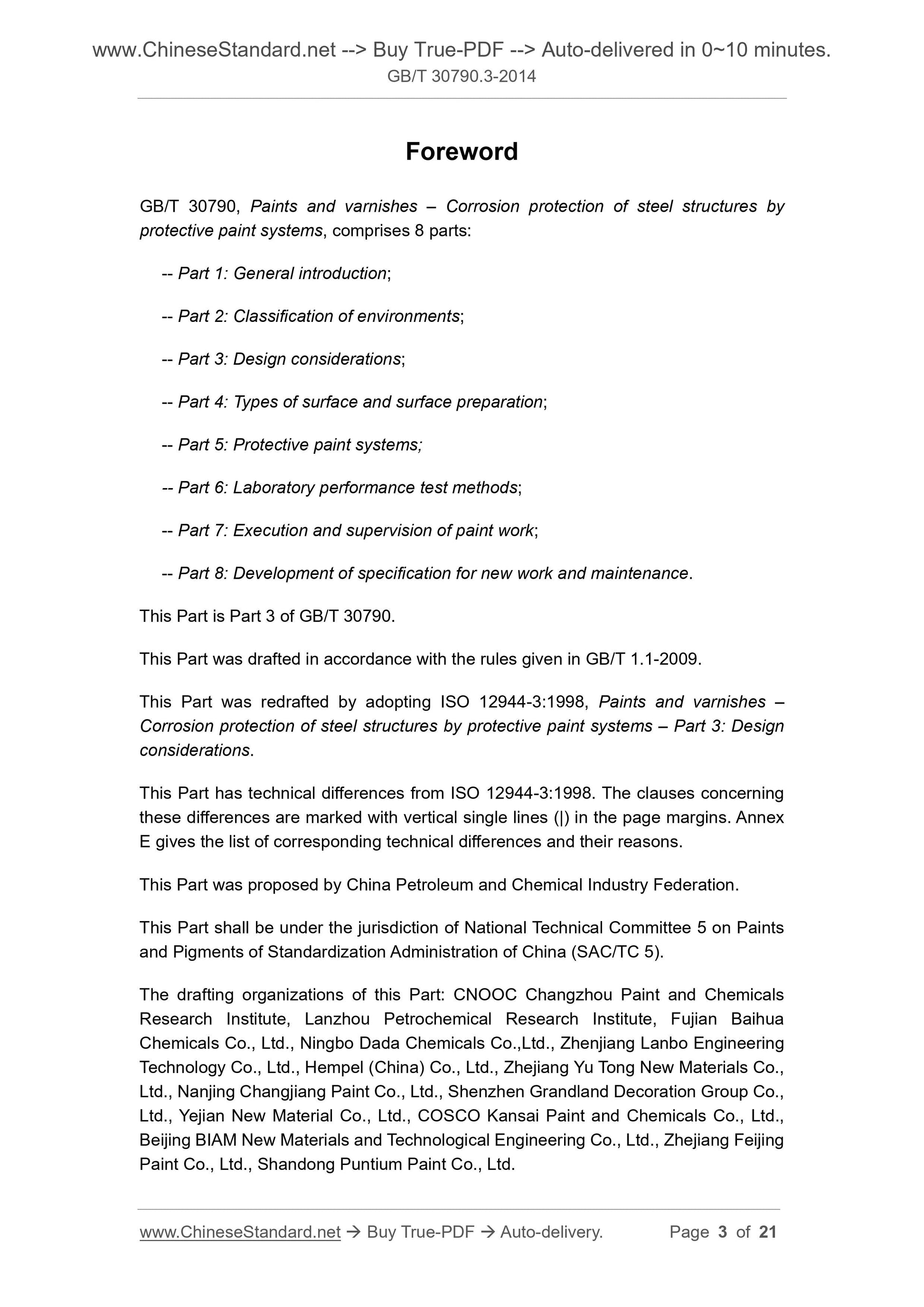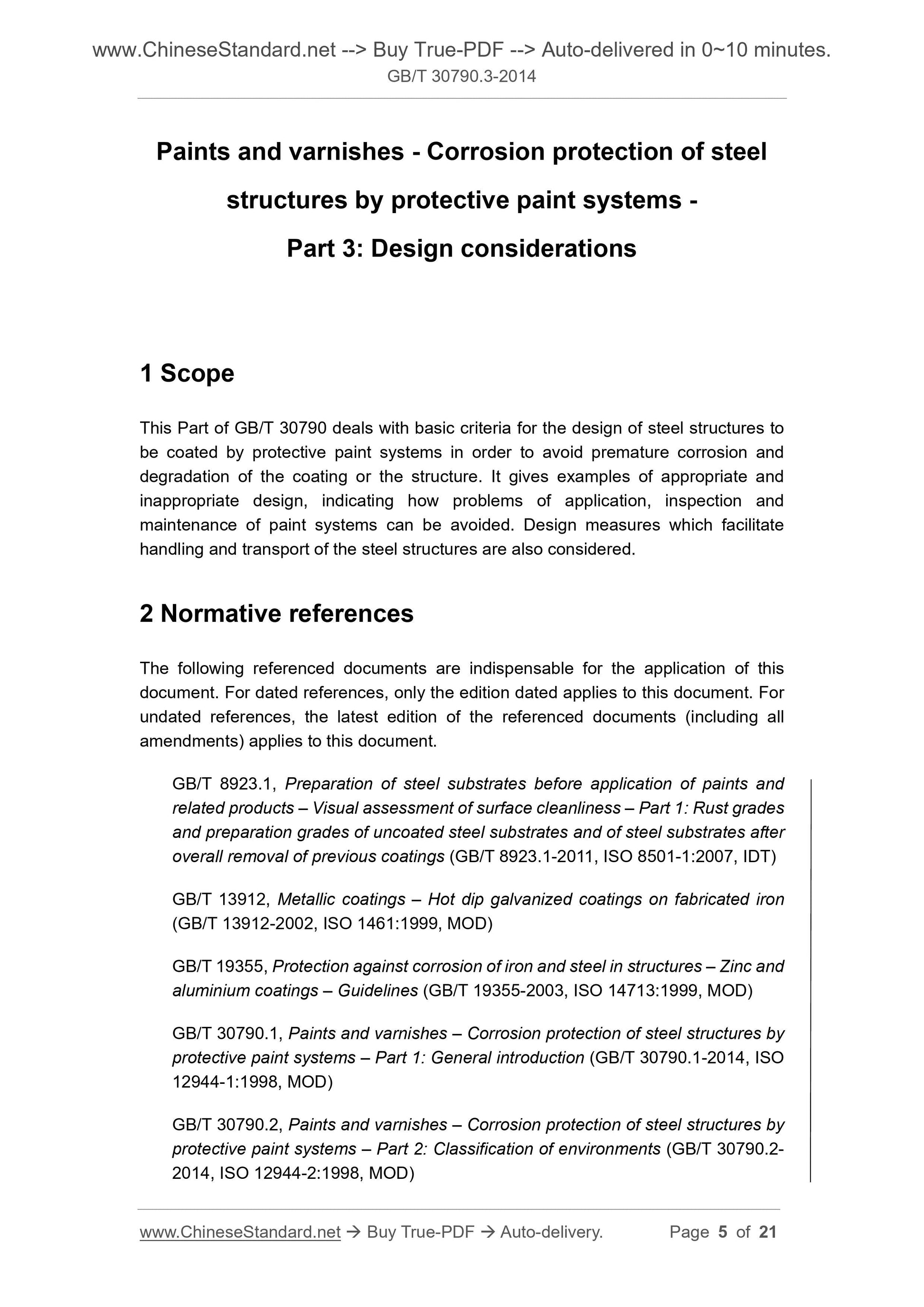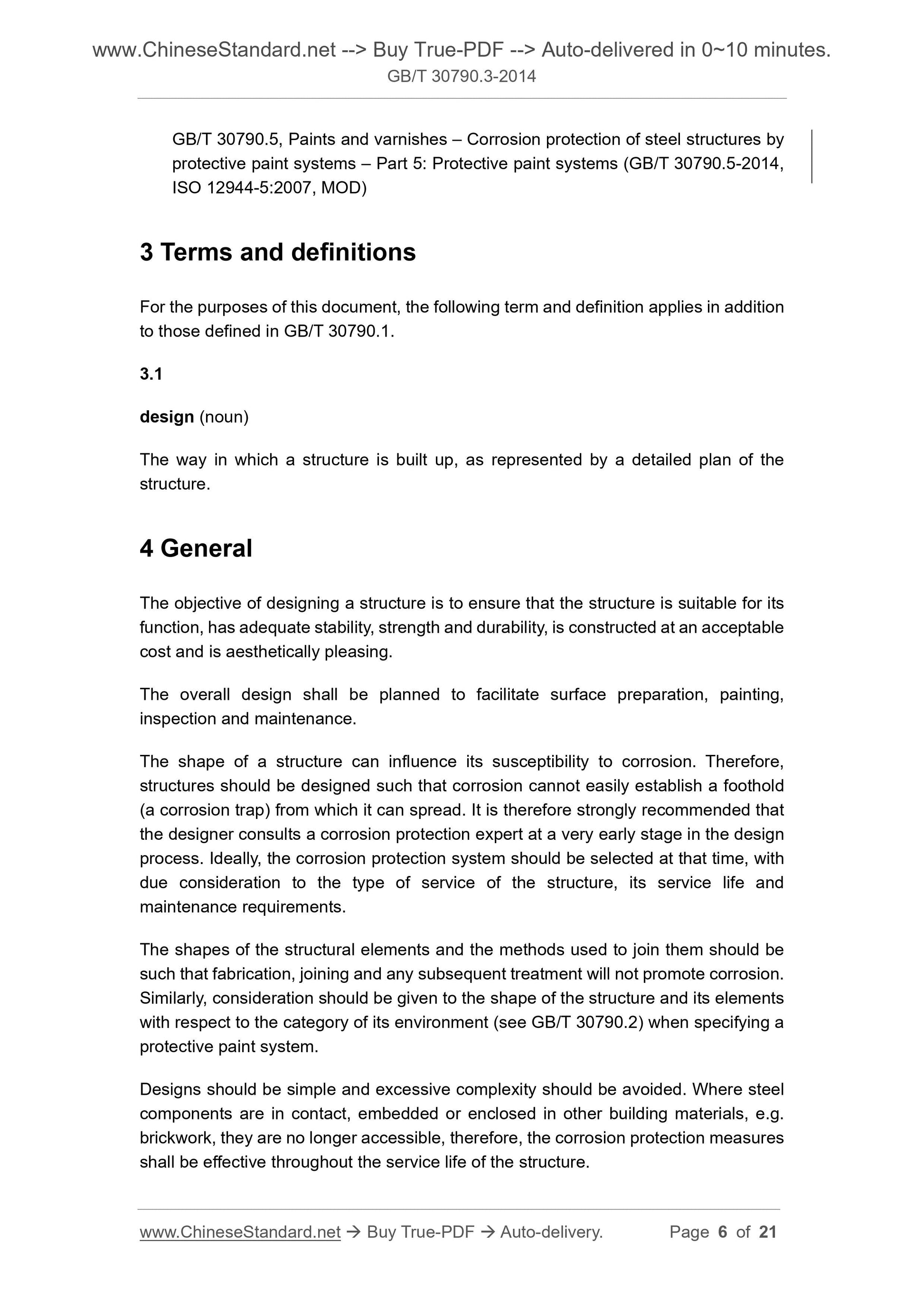1
/
of
5
www.ChineseStandard.us -- Field Test Asia Pte. Ltd.
GB/T 30790.3-2014 English PDF (GB/T30790.3-2014)
GB/T 30790.3-2014 English PDF (GB/T30790.3-2014)
Regular price
$150.00
Regular price
Sale price
$150.00
Unit price
/
per
Shipping calculated at checkout.
Couldn't load pickup availability
GB/T 30790.3-2014: Paints and varnishes -- Corrosion protection of steel structures by protective paint systems -- Part 3: Design considerations
Delivery: 9 seconds. Download (& Email) true-PDF + Invoice.
Get Quotation: Click GB/T 30790.3-2014 (Self-service in 1-minute)
Historical versions (Master-website): GB/T 30790.3-2014
Preview True-PDF (Reload/Scroll-down if blank)
GB/T 30790.3-2014
GB
NATIONAL STANDARD OF THE
PEOPLE’S REPUBLIC OF CHINA
ICS 87.020
G 50
Paints and varnishes – Corrosion protection of steel
structures by protective paint systems -
Part 3. Design considerations
(ISO 12944-3.1998, MOD)
ISSUED ON. JULY 8, 2014
IMPLEMENTED ON. DECEMBER 1, 2014
Issued by. General Administration of Quality Supervision, Inspection and
Quarantine of the People's Republic of China;
Standardization Administration of the People's Republic of
China.
Table of Contents
Foreword ... 3
1 Scope ... 5
2 Normative references ... 5
3 Terms and definitions ... 6
4 General ... 6
5 Basic design criteria for corrosion protection purposes ... 7
Annex A (Informative) Accessibility – Typical distances required for tools in
corrosion protection work ... 12
Annex B (Informative) Recommended minimum dimensions of openings for
access to confined areas ... 14
Annex C (Informative) Minimum dimensions for narrow spaces between
surfaces ... 15
Annex D (Informative) Design features which may be used to avoid deposits
accumulating or water being trapped ... 17
Annex E (Informative) Technical differences between this Part and ISO
12944-3.1998 and their reasons ... 21
Foreword
GB/T 30790, Paints and varnishes – Corrosion protection of steel structures by
protective paint systems, comprises 8 parts.
-- Part 1. General introduction;
-- Part 2. Classification of environments;
-- Part 3. Design considerations;
-- Part 4. Types of surface and surface preparation;
-- Part 5. Protective paint systems;
-- Part 6. Laboratory performance test methods;
-- Part 7. Execution and supervision of paint work;
-- Part 8. Development of specification for new work and maintenance.
This Part is Part 3 of GB/T 30790.
This Part was drafted in accordance with the rules given in GB/T 1.1-2009.
This Part was redrafted by adopting ISO 12944-3.1998, Paints and varnishes –
Corrosion protection of steel structures by protective paint systems – Part 3. Design
considerations.
This Part has technical differences from ISO 12944-3.1998. The clauses concerning
these differences are marked with vertical single lines (|) in the page margins. Annex
E gives the list of corresponding technical differences and their reasons.
This Part was proposed by China Petroleum and Chemical Industry Federation.
This Part shall be under the jurisdiction of National Technical Committee 5 on Paints
and Pigments of Standardization Administration of China (SAC/TC 5).
The drafting organizations of this Part. CNOOC Changzhou Paint and Chemicals
Research Institute, Lanzhou Petrochemical Research Institute, Fujian Baihua
Chemicals Co., Ltd., Ningbo Dada Chemicals Co.,Ltd., Zhenjiang Lanbo Engineering
Technology Co., Ltd., Hempel (China) Co., Ltd., Zhejiang Yu Tong New Materials Co.,
Ltd., Nanjing Changjiang Paint Co., Ltd., Shenzhen Grandland Decoration Group Co.,
Ltd., Yejian New Material Co., Ltd., COSCO Kansai Paint and Chemicals Co., Ltd.,
Beijing BIAM New Materials and Technological Engineering Co., Ltd., Zhejiang Feijing
Paint Co., Ltd., Shandong Puntium Paint Co., Ltd.
Paints and varnishes - Corrosion protection of steel
structures by protective paint systems -
Part 3. Design considerations
1 Scope
This Part of GB/T 30790 deals with basic criteria for the design of steel structures to
be coated by protective paint systems in order to avoid premature corrosion and
degradation of the coating or the structure. It gives examples of appropriate and
inappropriate design, indicating how problems of application, inspection and
maintenance of paint systems can be avoided. Design measures which facilitate
handling and transport of the steel structures are also considered.
2 Normative references
The following referenced documents are indispensable for the application of this
document. For dated references, only the edition dated applies to this document. For
undated references, the latest edition of the referenced documents (including all
amendments) applies to this document.
GB/T 8923.1, Preparation of steel substrates before application of paints and
related products – Visual assessment of surface cleanliness – Part 1. Rust grades
and preparation grades of uncoated steel substrates and of steel substrates after
overall removal of previous coatings (GB/T 8923.1-2011, ISO 8501-1.2007, IDT)
GB/T 13912, Metallic coatings – Hot dip galvanized coatings on fabricated iron
(GB/T 13912-2002, ISO 1461.1999, MOD)
GB/T 19355, Protection against corrosion of iron and steel in structures – Zinc and
aluminium coatings – Guidelines (GB/T 19355-2003, ISO 14713.1999, MOD)
GB/T 30790.1, Paints and varnishes – Corrosion protection of steel structures by
protective paint systems – Part 1. General introduction (GB/T 30790.1-2014, ISO
12944-1.1998, MOD)
GB/T 30790.2, Paints and varnishes – Corrosion protection of steel structures by
protective paint systems – Part 2. Classification of environments (GB/T 30790.2-
2014, ISO 12944-2.1998, MOD)
GB/T 30790.5, Paints and varnishes – Corrosion protection of steel structures by
protective paint systems – Part 5. Protective paint systems (GB/T 30790.5-2014,
ISO 12944-5.2007, MOD)
3 Terms and definitions
For the purposes of this document, the following term and definition applies in addition
to those defined in GB/T 30790.1.
3.1
design (noun)
The way in which a structure is built up, as represented by a detailed plan of the
structure.
4 General
The objective of designing a structure is to ensure that the structure is suitable for its
function, has adequate stability, strength and durability, is constructed at an acceptable
cost and is aesthetically pleasing.
The overall design shall be planned to facilitate surface preparation, painting,
inspection and maintenance.
The shape of a structure can influence its susceptibility to corrosion. Therefore,
structures should be designed such that corrosion cannot easily establish a foothold
(a corrosion trap) from which it can spread. It is therefore strongly recommended that
the designer consults a corrosion protection expert at a very early stage in the design
process. Ideally, the corrosion protection system should be selected at that time, with
due consideration to the type of service of the structure, its service life and
maintenance requirements.
The shapes of the structural elements and the methods used to join them should be
such that fabrication, joining and any subsequent treatment will not promote corrosion.
Similarly, consideration should be given to the shape of the structure and its elements
with respect to the category of its environment (see GB/T 30790.2) when specifying a
protective paint system.
Designs should be simple and excessive complexity should be avoided. Where steel
components are in contact, embedded or enclosed in other building materials, e.g.
brickwork, they are no longer accessible, therefore, the corrosion protection measures
shall be effective throughout the service life of the structure.
GB/T 30790.3-2014
GB
NATIONAL STANDARD OF THE
PEOPLE’S REPUBLIC OF CHINA
ICS 87.020
G 50
Paints and varnishes – Corrosion protection of steel
structures by protective paint systems -
Part 3. Design considerations
(ISO 12944-3.1998, MOD)
ISSUED ON. JULY 8, 2014
IMPLEMENTED ON. DECEMBER 1, 2014
Issued by. General Administration of Quality Supervision, Inspection and
Quarantine of the People's Republic of China;
Standardization Administration of the People's Republic of
China.
Table of Contents
Foreword ... 3
1 Scope ... 5
2 Normative references ... 5
3 Terms and definitions ... 6
4 General ... 6
5 Basic design criteria for corrosion protection purposes ... 7
Annex A (Informative) Accessibility – Typical distances required for tools in
corrosion protection work ... 12
Annex B (Informative) Recommended minimum dimensions of openings for
access to confined areas ... 14
Annex C (Informative) Minimum dimensions for narrow spaces between
surfaces ... 15
Annex D (Informative) Design features which may be used to avoid deposits
accumulating or water being trapped ... 17
Annex E (Informative) Technical differences between this Part and ISO
12944-3.1998 and their reasons ... 21
Foreword
GB/T 30790, Paints and varnishes – Corrosion protection of steel structures by
protective paint systems, comprises 8 parts.
-- Part 1. General introduction;
-- Part 2. Classification of environments;
-- Part 3. Design considerations;
-- Part 4. Types of surface and surface preparation;
-- Part 5. Protective paint systems;
-- Part 6. Laboratory performance test methods;
-- Part 7. Execution and supervision of paint work;
-- Part 8. Development of specification for new work and maintenance.
This Part is Part 3 of GB/T 30790.
This Part was drafted in accordance with the rules given in GB/T 1.1-2009.
This Part was redrafted by adopting ISO 12944-3.1998, Paints and varnishes –
Corrosion protection of steel structures by protective paint systems – Part 3. Design
considerations.
This Part has technical differences from ISO 12944-3.1998. The clauses concerning
these differences are marked with vertical single lines (|) in the page margins. Annex
E gives the list of corresponding technical differences and their reasons.
This Part was proposed by China Petroleum and Chemical Industry Federation.
This Part shall be under the jurisdiction of National Technical Committee 5 on Paints
and Pigments of Standardization Administration of China (SAC/TC 5).
The drafting organizations of this Part. CNOOC Changzhou Paint and Chemicals
Research Institute, Lanzhou Petrochemical Research Institute, Fujian Baihua
Chemicals Co., Ltd., Ningbo Dada Chemicals Co.,Ltd., Zhenjiang Lanbo Engineering
Technology Co., Ltd., Hempel (China) Co., Ltd., Zhejiang Yu Tong New Materials Co.,
Ltd., Nanjing Changjiang Paint Co., Ltd., Shenzhen Grandland Decoration Group Co.,
Ltd., Yejian New Material Co., Ltd., COSCO Kansai Paint and Chemicals Co., Ltd.,
Beijing BIAM New Materials and Technological Engineering Co., Ltd., Zhejiang Feijing
Paint Co., Ltd., Shandong Puntium Paint Co., Ltd.
Paints and varnishes - Corrosion protection of steel
structures by protective paint systems -
Part 3. Design considerations
1 Scope
This Part of GB/T 30790 deals with basic criteria for the design of steel structures to
be coated by protective paint systems in order to avoid premature corrosion and
degradation of the coating or the structure. It gives examples of appropriate and
inappropriate design, indicating how problems of application, inspection and
maintenance of paint systems can be avoided. Design measures which facilitate
handling and transport of the steel structures are also considered.
2 Normative references
The following referenced documents are indispensable for the application of this
document. For dated references, only the edition dated applies to this document. For
undated references, the latest edition of the referenced documents (including all
amendments) applies to this document.
GB/T 8923.1, Preparation of steel substrates before application of paints and
related products – Visual assessment of surface cleanliness – Part 1. Rust grades
and preparation grades of uncoated steel substrates and of steel substrates after
overall removal of previous coatings (GB/T 8923.1-2011, ISO 8501-1.2007, IDT)
GB/T 13912, Metallic coatings – Hot dip galvanized coatings on fabricated iron
(GB/T 13912-2002, ISO 1461.1999, MOD)
GB/T 19355, Protection against corrosion of iron and steel in structures – Zinc and
aluminium coatings – Guidelines (GB/T 19355-2003, ISO 14713.1999, MOD)
GB/T 30790.1, Paints and varnishes – Corrosion protection of steel structures by
protective paint systems – Part 1. General introduction (GB/T 30790.1-2014, ISO
12944-1.1998, MOD)
GB/T 30790.2, Paints and varnishes – Corrosion protection of steel structures by
protective paint systems – Part 2. Classification of environments (GB/T 30790.2-
2014, ISO 12944-2.1998, MOD)
GB/T 30790.5, Paints and varnishes – Corrosion protection of steel structures by
protective paint systems – Part 5. Protective paint systems (GB/T 30790.5-2014,
ISO 12944-5.2007, MOD)
3 Terms and definitions
For the purposes of this document, the following term and definition applies in addition
to those defined in GB/T 30790.1.
3.1
design (noun)
The way in which a structure is built up, as represented by a detailed plan of the
structure.
4 General
The objective of designing a structure is to ensure that the structure is suitable for its
function, has adequate stability, strength and durability, is constructed at an acceptable
cost and is aesthetically pleasing.
The overall design shall be planned to facilitate surface preparation, painting,
inspection and maintenance.
The shape of a structure can influence its susceptibility to corrosion. Therefore,
structures should be designed such that corrosion cannot easily establish a foothold
(a corrosion trap) from which it can spread. It is therefore strongly recommended that
the designer consults a corrosion protection expert at a very early stage in the design
process. Ideally, the corrosion protection system should be selected at that time, with
due consideration to the type of service of the structure, its service life and
maintenance requirements.
The shapes of the structural elements and the methods used to join them should be
such that fabrication, joining and any subsequent treatment will not promote corrosion.
Similarly, consideration should be given to the shape of the structure and its elements
with respect to the category of its environment (see GB/T 30790.2) when specifying a
protective paint system.
Designs should be simple and excessive complexity should be avoided. Where steel
components are in contact, embedded or enclosed in other building materials, e.g.
brickwork, they are no longer ac...
Delivery: 9 seconds. Download (& Email) true-PDF + Invoice.
Get Quotation: Click GB/T 30790.3-2014 (Self-service in 1-minute)
Historical versions (Master-website): GB/T 30790.3-2014
Preview True-PDF (Reload/Scroll-down if blank)
GB/T 30790.3-2014
GB
NATIONAL STANDARD OF THE
PEOPLE’S REPUBLIC OF CHINA
ICS 87.020
G 50
Paints and varnishes – Corrosion protection of steel
structures by protective paint systems -
Part 3. Design considerations
(ISO 12944-3.1998, MOD)
ISSUED ON. JULY 8, 2014
IMPLEMENTED ON. DECEMBER 1, 2014
Issued by. General Administration of Quality Supervision, Inspection and
Quarantine of the People's Republic of China;
Standardization Administration of the People's Republic of
China.
Table of Contents
Foreword ... 3
1 Scope ... 5
2 Normative references ... 5
3 Terms and definitions ... 6
4 General ... 6
5 Basic design criteria for corrosion protection purposes ... 7
Annex A (Informative) Accessibility – Typical distances required for tools in
corrosion protection work ... 12
Annex B (Informative) Recommended minimum dimensions of openings for
access to confined areas ... 14
Annex C (Informative) Minimum dimensions for narrow spaces between
surfaces ... 15
Annex D (Informative) Design features which may be used to avoid deposits
accumulating or water being trapped ... 17
Annex E (Informative) Technical differences between this Part and ISO
12944-3.1998 and their reasons ... 21
Foreword
GB/T 30790, Paints and varnishes – Corrosion protection of steel structures by
protective paint systems, comprises 8 parts.
-- Part 1. General introduction;
-- Part 2. Classification of environments;
-- Part 3. Design considerations;
-- Part 4. Types of surface and surface preparation;
-- Part 5. Protective paint systems;
-- Part 6. Laboratory performance test methods;
-- Part 7. Execution and supervision of paint work;
-- Part 8. Development of specification for new work and maintenance.
This Part is Part 3 of GB/T 30790.
This Part was drafted in accordance with the rules given in GB/T 1.1-2009.
This Part was redrafted by adopting ISO 12944-3.1998, Paints and varnishes –
Corrosion protection of steel structures by protective paint systems – Part 3. Design
considerations.
This Part has technical differences from ISO 12944-3.1998. The clauses concerning
these differences are marked with vertical single lines (|) in the page margins. Annex
E gives the list of corresponding technical differences and their reasons.
This Part was proposed by China Petroleum and Chemical Industry Federation.
This Part shall be under the jurisdiction of National Technical Committee 5 on Paints
and Pigments of Standardization Administration of China (SAC/TC 5).
The drafting organizations of this Part. CNOOC Changzhou Paint and Chemicals
Research Institute, Lanzhou Petrochemical Research Institute, Fujian Baihua
Chemicals Co., Ltd., Ningbo Dada Chemicals Co.,Ltd., Zhenjiang Lanbo Engineering
Technology Co., Ltd., Hempel (China) Co., Ltd., Zhejiang Yu Tong New Materials Co.,
Ltd., Nanjing Changjiang Paint Co., Ltd., Shenzhen Grandland Decoration Group Co.,
Ltd., Yejian New Material Co., Ltd., COSCO Kansai Paint and Chemicals Co., Ltd.,
Beijing BIAM New Materials and Technological Engineering Co., Ltd., Zhejiang Feijing
Paint Co., Ltd., Shandong Puntium Paint Co., Ltd.
Paints and varnishes - Corrosion protection of steel
structures by protective paint systems -
Part 3. Design considerations
1 Scope
This Part of GB/T 30790 deals with basic criteria for the design of steel structures to
be coated by protective paint systems in order to avoid premature corrosion and
degradation of the coating or the structure. It gives examples of appropriate and
inappropriate design, indicating how problems of application, inspection and
maintenance of paint systems can be avoided. Design measures which facilitate
handling and transport of the steel structures are also considered.
2 Normative references
The following referenced documents are indispensable for the application of this
document. For dated references, only the edition dated applies to this document. For
undated references, the latest edition of the referenced documents (including all
amendments) applies to this document.
GB/T 8923.1, Preparation of steel substrates before application of paints and
related products – Visual assessment of surface cleanliness – Part 1. Rust grades
and preparation grades of uncoated steel substrates and of steel substrates after
overall removal of previous coatings (GB/T 8923.1-2011, ISO 8501-1.2007, IDT)
GB/T 13912, Metallic coatings – Hot dip galvanized coatings on fabricated iron
(GB/T 13912-2002, ISO 1461.1999, MOD)
GB/T 19355, Protection against corrosion of iron and steel in structures – Zinc and
aluminium coatings – Guidelines (GB/T 19355-2003, ISO 14713.1999, MOD)
GB/T 30790.1, Paints and varnishes – Corrosion protection of steel structures by
protective paint systems – Part 1. General introduction (GB/T 30790.1-2014, ISO
12944-1.1998, MOD)
GB/T 30790.2, Paints and varnishes – Corrosion protection of steel structures by
protective paint systems – Part 2. Classification of environments (GB/T 30790.2-
2014, ISO 12944-2.1998, MOD)
GB/T 30790.5, Paints and varnishes – Corrosion protection of steel structures by
protective paint systems – Part 5. Protective paint systems (GB/T 30790.5-2014,
ISO 12944-5.2007, MOD)
3 Terms and definitions
For the purposes of this document, the following term and definition applies in addition
to those defined in GB/T 30790.1.
3.1
design (noun)
The way in which a structure is built up, as represented by a detailed plan of the
structure.
4 General
The objective of designing a structure is to ensure that the structure is suitable for its
function, has adequate stability, strength and durability, is constructed at an acceptable
cost and is aesthetically pleasing.
The overall design shall be planned to facilitate surface preparation, painting,
inspection and maintenance.
The shape of a structure can influence its susceptibility to corrosion. Therefore,
structures should be designed such that corrosion cannot easily establish a foothold
(a corrosion trap) from which it can spread. It is therefore strongly recommended that
the designer consults a corrosion protection expert at a very early stage in the design
process. Ideally, the corrosion protection system should be selected at that time, with
due consideration to the type of service of the structure, its service life and
maintenance requirements.
The shapes of the structural elements and the methods used to join them should be
such that fabrication, joining and any subsequent treatment will not promote corrosion.
Similarly, consideration should be given to the shape of the structure and its elements
with respect to the category of its environment (see GB/T 30790.2) when specifying a
protective paint system.
Designs should be simple and excessive complexity should be avoided. Where steel
components are in contact, embedded or enclosed in other building materials, e.g.
brickwork, they are no longer accessible, therefore, the corrosion protection measures
shall be effective throughout the service life of the structure.
GB/T 30790.3-2014
GB
NATIONAL STANDARD OF THE
PEOPLE’S REPUBLIC OF CHINA
ICS 87.020
G 50
Paints and varnishes – Corrosion protection of steel
structures by protective paint systems -
Part 3. Design considerations
(ISO 12944-3.1998, MOD)
ISSUED ON. JULY 8, 2014
IMPLEMENTED ON. DECEMBER 1, 2014
Issued by. General Administration of Quality Supervision, Inspection and
Quarantine of the People's Republic of China;
Standardization Administration of the People's Republic of
China.
Table of Contents
Foreword ... 3
1 Scope ... 5
2 Normative references ... 5
3 Terms and definitions ... 6
4 General ... 6
5 Basic design criteria for corrosion protection purposes ... 7
Annex A (Informative) Accessibility – Typical distances required for tools in
corrosion protection work ... 12
Annex B (Informative) Recommended minimum dimensions of openings for
access to confined areas ... 14
Annex C (Informative) Minimum dimensions for narrow spaces between
surfaces ... 15
Annex D (Informative) Design features which may be used to avoid deposits
accumulating or water being trapped ... 17
Annex E (Informative) Technical differences between this Part and ISO
12944-3.1998 and their reasons ... 21
Foreword
GB/T 30790, Paints and varnishes – Corrosion protection of steel structures by
protective paint systems, comprises 8 parts.
-- Part 1. General introduction;
-- Part 2. Classification of environments;
-- Part 3. Design considerations;
-- Part 4. Types of surface and surface preparation;
-- Part 5. Protective paint systems;
-- Part 6. Laboratory performance test methods;
-- Part 7. Execution and supervision of paint work;
-- Part 8. Development of specification for new work and maintenance.
This Part is Part 3 of GB/T 30790.
This Part was drafted in accordance with the rules given in GB/T 1.1-2009.
This Part was redrafted by adopting ISO 12944-3.1998, Paints and varnishes –
Corrosion protection of steel structures by protective paint systems – Part 3. Design
considerations.
This Part has technical differences from ISO 12944-3.1998. The clauses concerning
these differences are marked with vertical single lines (|) in the page margins. Annex
E gives the list of corresponding technical differences and their reasons.
This Part was proposed by China Petroleum and Chemical Industry Federation.
This Part shall be under the jurisdiction of National Technical Committee 5 on Paints
and Pigments of Standardization Administration of China (SAC/TC 5).
The drafting organizations of this Part. CNOOC Changzhou Paint and Chemicals
Research Institute, Lanzhou Petrochemical Research Institute, Fujian Baihua
Chemicals Co., Ltd., Ningbo Dada Chemicals Co.,Ltd., Zhenjiang Lanbo Engineering
Technology Co., Ltd., Hempel (China) Co., Ltd., Zhejiang Yu Tong New Materials Co.,
Ltd., Nanjing Changjiang Paint Co., Ltd., Shenzhen Grandland Decoration Group Co.,
Ltd., Yejian New Material Co., Ltd., COSCO Kansai Paint and Chemicals Co., Ltd.,
Beijing BIAM New Materials and Technological Engineering Co., Ltd., Zhejiang Feijing
Paint Co., Ltd., Shandong Puntium Paint Co., Ltd.
Paints and varnishes - Corrosion protection of steel
structures by protective paint systems -
Part 3. Design considerations
1 Scope
This Part of GB/T 30790 deals with basic criteria for the design of steel structures to
be coated by protective paint systems in order to avoid premature corrosion and
degradation of the coating or the structure. It gives examples of appropriate and
inappropriate design, indicating how problems of application, inspection and
maintenance of paint systems can be avoided. Design measures which facilitate
handling and transport of the steel structures are also considered.
2 Normative references
The following referenced documents are indispensable for the application of this
document. For dated references, only the edition dated applies to this document. For
undated references, the latest edition of the referenced documents (including all
amendments) applies to this document.
GB/T 8923.1, Preparation of steel substrates before application of paints and
related products – Visual assessment of surface cleanliness – Part 1. Rust grades
and preparation grades of uncoated steel substrates and of steel substrates after
overall removal of previous coatings (GB/T 8923.1-2011, ISO 8501-1.2007, IDT)
GB/T 13912, Metallic coatings – Hot dip galvanized coatings on fabricated iron
(GB/T 13912-2002, ISO 1461.1999, MOD)
GB/T 19355, Protection against corrosion of iron and steel in structures – Zinc and
aluminium coatings – Guidelines (GB/T 19355-2003, ISO 14713.1999, MOD)
GB/T 30790.1, Paints and varnishes – Corrosion protection of steel structures by
protective paint systems – Part 1. General introduction (GB/T 30790.1-2014, ISO
12944-1.1998, MOD)
GB/T 30790.2, Paints and varnishes – Corrosion protection of steel structures by
protective paint systems – Part 2. Classification of environments (GB/T 30790.2-
2014, ISO 12944-2.1998, MOD)
GB/T 30790.5, Paints and varnishes – Corrosion protection of steel structures by
protective paint systems – Part 5. Protective paint systems (GB/T 30790.5-2014,
ISO 12944-5.2007, MOD)
3 Terms and definitions
For the purposes of this document, the following term and definition applies in addition
to those defined in GB/T 30790.1.
3.1
design (noun)
The way in which a structure is built up, as represented by a detailed plan of the
structure.
4 General
The objective of designing a structure is to ensure that the structure is suitable for its
function, has adequate stability, strength and durability, is constructed at an acceptable
cost and is aesthetically pleasing.
The overall design shall be planned to facilitate surface preparation, painting,
inspection and maintenance.
The shape of a structure can influence its susceptibility to corrosion. Therefore,
structures should be designed such that corrosion cannot easily establish a foothold
(a corrosion trap) from which it can spread. It is therefore strongly recommended that
the designer consults a corrosion protection expert at a very early stage in the design
process. Ideally, the corrosion protection system should be selected at that time, with
due consideration to the type of service of the structure, its service life and
maintenance requirements.
The shapes of the structural elements and the methods used to join them should be
such that fabrication, joining and any subsequent treatment will not promote corrosion.
Similarly, consideration should be given to the shape of the structure and its elements
with respect to the category of its environment (see GB/T 30790.2) when specifying a
protective paint system.
Designs should be simple and excessive complexity should be avoided. Where steel
components are in contact, embedded or enclosed in other building materials, e.g.
brickwork, they are no longer ac...
Share
